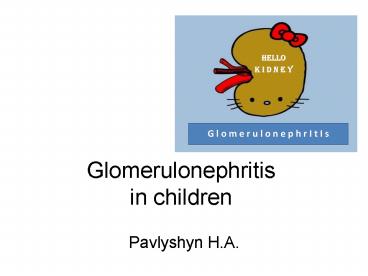Glomerulonephritis in children - PowerPoint PPT Presentation
1 / 32
Title:
Glomerulonephritis in children
Description:
Glomerulonephritis in children Pavlyshyn H.A. Presentation Hematuria with Proteinuria with Dysmorphic rbcs with Rbc casts Oliguria Volume overload Hypertension Liquid ... – PowerPoint PPT presentation
Number of Views:509
Avg rating:3.0/5.0
Title: Glomerulonephritis in children
1
Glomerulonephritis in children
- Pavlyshyn H.A.
2
(No Transcript)
3
Definition
- Acute glomerulonephritis is the inflammation of
the glomeruli which causes the kidneys to
malfunction - It is also called Acute Nephritis,
Glomerulonephritis and Post-Streptococcal
Glomerulonephritis - Predominantly affects children from ages 2 to 12
- Incubation period is 2 to 3 weeks
4
(No Transcript)
5
(No Transcript)
6
(No Transcript)
7
Autoimmune Reactions
Some progress as either focal segmental
glomerulosclerosis or tubulointerstitial nephritis
8
Possible Clinical Manifestations
- Proteinuria asymptomatic
- Haematuria asymptomatic
- Hypertension
- Nephrotic syndrome
- Nephritic syndrome
- Acute renal failure
- Rapidly progressive renal failure
- End stage renal failure
8
9
Presentation
- Hematuria
- with Proteinuria
- with Dysmorphic rbcs
- with Rbc casts
- Oliguria
- Volume overload
- Hypertension
10
Liquid Renal Biopsy
11
Urine Sediment Analysis
G4 cell
12
Other HP findings
- Neurological changes
- Pharyngitis
- URI / sinusitis
- Hemoptysis
- Rash
- Murmur
- Arthritis
- Edema
13
Complement Abnormalities
Ab-Ag complexes
Classical pathway
C3 convertase
14
Differential Diagnosis
- Hypocomplementemia
- PIGN
- MPGN
- SLE
- Cryoglobulinemia
- Bacterial Endocarditis
- Shunt nephritis
- Normal complement
- HUS
- IgAN
- HSP
- Alports / TBMD
15
b-hemolytic Streptococci
- Most common organism in PIGN
- 20 children are asymptomatic carriers
- Nephritic factor
- Host susceptibility factors (HLA-DR)
- Treatment of prodromal illness doesnt prevent
nephritis - ASO titers are NOT helpful
16
Post Infectious GN
- Pathogenesis
- Strep antigens trigger antibodies that
cross-react to glomeruli - Circulating immune complexes get filtered by
glomerulus get stuck - Immune complexes activate complement
- Diffuse generalized damage to glomeruli
- ? GFR due to inflammation, damage to BM
- ? RBF in proportion to GFR, so filtration
fraction normal - Tubular function is preserved
- Plasma renin and aldosterone are normal
- Presentation
- 7-14 days after pharyngitis
- 14-21 days after impetigo (upto 6 wks)
- Abrupt onset
17
Manifestations of PIGN
- Edema 85
- HTN 60-80
- Gross hematuria 25-33
- CNS (i.e. Sz) 10
- Nephrotic syndrome rare
- ARF not uncommon
- C3 decreased
- C4 typically normal
18
Management of PIGN
- Antibiotics do NOT prevent GN
- Sodium Fluid restriction
- Antihypertensives, diuretics for HTN
- Dialysis if necessary
- Prognosis usually excellent
- 0.5 mortality due to pulmonary edema or
pneumonia - lt1 progress to CKD stage 5
- Follow-up
- Gross hematuria resolves within 2 weeks
- Complement low for 6-8 weeks
- Proteinuria remains upto 6 months
- Hematuria remains upto 2 years
19
Renal Biopsy
20
Histopathology
- Diffuse all glomeruli
- Generalized all segments of glomeruli
21
IgG Immunofluorescence
Starry Sky Pattern
22
Electron microscopy - Normal
23
Electron microscopy of PIGN
- Subepithelial immune deposits (humps)
- Mesangial, subendothelial, intramembranous
deposits less common - Effacement of foot processes
24
Hemolytic Uremic Syndrome
- 2 cases/100,000 annually
- Peak incidence lt5yo (6/100,000)
- More common June-September
- Classification
- D diarrhea associated
- Strep pneumo
- Atypical HUS ADAM-TS13, C1q def
25
Presentation of D HUS
- Prodromal acute gastroenteritis
- Shiga toxin producing E.coli O157H7
- Transmission from beef, veggies, direct
person-to-person, and contaminated water all
reported - Incubation period 3-4 days
- Bloody diarrhea 2-3 days after cramping begins
- 50 with emesis, afebrile or low grade fever only
- Hemolytic anemia
- Thrombocytopenia
- ARF
- Begins 2-14 days after diarrhea
- CNS disease
- Overlap with ITP in 33 HUS cases
- Somnolence, confusion, seizures, coma
26
Microangiopathic Hemolytic Anemia
27
Henoch Schönlein Purupura
28
Henoch Schönlein Purupura
- GI tract
- Cramping, vomiting, diarrhea
- Skin rash
- Lower extremities, buttocks
- Joint involvement
- HSP nephritis
- Incidence 20-50
- In 80, occurs within 4 weeks of rash GI upset
- In 15, occurs upto 1-3 months after rash GI
upset
29
Pathogenesis of Alports
- Abnormality of type IV collagen
- Disordered basement membrane
- Splitting of lamina densa of GBM
30
Crescentic GN
Type Serology Primary Secondary
I Anti-GBM ANCA- Anti-GBM disease Goodpastures
II Anti-GBM- ANCA- idiopathic SLE, IgAN, MPGN
III Anti-GBM- ANCA Microscopic polyangiitis, Wegeners Drug-induced
IV Anti-GBM ANCA Anti-GBM disease Goodpastures
31
Vasculitides
- C-ANCA
P-ANCA
Anti-proteinase 3 antibodies
Anti-myeloperoxidase antibodies
75 sensitive for Wegeners
66 sensitive for Microscopic polyangiitis
32
Anti-GBM Disease
Silver stain
IgG immunofluorescence

